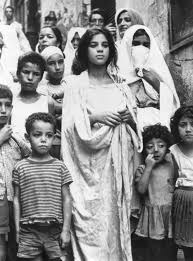This article was first published on Kashmir Reader on the 25th of August 2016.

I don’t understand those who don’t understand that politics comes also from the belly. Beyond the viscerality of a political existence, there are always contingent factors that, by chance or by necessity, force me to confront the reasons of what I chose, and the values for which I live. There is no looking away.
This time the occasion has come from a cup of salty tea, typical of Kashmir and of the Himalayan valleys on either side of the contested border between India and Pakistan.
A couple of days ago I was talking with one of my colleagues, he comes from Hunza, a picturesque and isolated valley 2500 meters above sea level in the extreme north of Pakistan. We were discussing about regional variations in recipes, habits and tradition of the salty tea. As he knows that I like it a lot, after our conversation he made it for me for breakfast. What he calls sheer or shur chai is a version (with butter and without baking soda) of what I know as nun chai and what for me represents the flavour of Kashmir.
Sitting across from each other, we had our tea in silence: our thoughts lost somewhere further East, in two different beautiful valleys of the Himalaya. As I was sipping from my cup, with my body in Kabul and my heart in Srinagar, he filled a bowl with bites of old bread, poured tea over them and ate the whole as a soup, nostalgically thinking of the breakfasts of his childhood.
My cup of sheer chai made me face what I had been avoiding for days.
As I write this I am sitting in Kabul, in a beautiful late summer day that started with an unreported explosion while I was making breakfast. By nature I am not particularly fearful, squeamish or impressionable, and years of work in countries in conflict made my skin pretty thick. Yet, what is happening in Kashmir feels incomprehensible, utterly incommensurable.
It has been for more than forty-six days that I have felt the need to write about the mayhem that has taken over Kashmir, but every passing day made finding the words more difficult. I kept procrastinating, used the fact that I am busy as an excuse and looked away. My guilt, however, kept growing: my silence was becoming a form of complicity. This is the time to speak up, to take sides: the end result of a concerned silence is not different from a lax or irresponsible indifference.
For the past forty-six days the Valley has been under siege. After the killing of Burhan Wani, the young, indigenous, non-Pakistan sponsored, rebel commander fighting against Indian rule in the name of self-determination, Kashmir erupted and took it to the streets. This was by no means unannounced, the rage was simmering and slowly mounting under the surface. Those who cared looking, knew far too well that it was only a matter of time. Nobody, however, could predict that things would escalate to this level.
India responded to protests and stone pelting with an iron fist: with an unprecedented and unimaginable violence. In forty-six days almost seventy people have been killed, at least 6,000 were injured and more than 500 have been hit, mostly in the eye, by pellet guns. Curfew has been extended to both day and night, making it almost impossible even to buy milk. The Border Security Force has once again been deployed in Srinagar, a frightening reminder of the 1990s, certainly not a measure encouraging dialogue. A few days ago the Army prevented the distribution of petrol and an ambulance driver was shot at as he was taking several wounded people to the hospital.

After the 8th of July, when it became clear that the use of so called non-lethal weapons such as pellet guns would be part of the daily updates, it occurred to me that I had never seen one (why should I after all?) and I could not really grasp how the idea of non-lethal could possibly sit in the same sentence with a firearm. Not knowing how else I could educate myself on the subject, I thought I would check on YouTube. After a bit of browsing, and studiously trying to avoid gory images, I stumbled upon a video shot somewhere in suburban America. The protagonist was a white young man who was defending the efficiency of the pellet gun with spherical projectiles against those detractors who were trying to discredit its firepower. To demonstrate the accuracy of his thesis, he shot at a watermelon at a close range. The fruit cracked open, and the young man showed to the camera with great satisfaction that the watermelon’s inside was smashed beyond recognition.
My heart stopped and I wondered why it was that I did that to myself. I just could not bring myself to think that this was what was happening in Kashmir, to the faces of children as young as five. And not with spherical projectiles, but with modified, irregular pellets that would tear to pieces whatever they would encounter.

Pellet Scars, Mir Suhail
Quite literally, by hitting in the eye, the Indian government forces are not killing people directly, is attempting to kill the idea of the future. It is systematically trying to remove the possibility of looking at the future in a manner that differs from what is envisaged by those in power. This makes me wonder who is it that is really blind: those whom violence have deprived of the sun light or those who think that violence and brutality can kill ideas.
How far can this go? Would an entire population deprived of eyesight stop seeing the way towards freedom, the path to azadi?
I think of my friends, of those who hold a very special place in my heart, of the mothers whose teenage sons are protesting in the streets. I think about the anger, the fear and the right to decide for themselves.
How can one write about all this? Where are the words to be found? The other night a friend told me that there’s no point in writing in times such as these because there is really nothing left to add. Maybe it is true, there are no words to give measure to such a horror and what I am writing is irrelevant, but never like now does silence feel culpable.
At times I wish we’d live in a simpler world where a cup of salty tea could be the trigger to start changing things.
Freedom’s terrible thirst, flooding Kashmir,
is bringing love to its tormented glass,
Stranger, who will inherit the last night of the past?
Of what shall I not sing, and sing?
Agha Shahid Ali






 50 years ago, the revolutionary masterpiece The Battle of Algiers by Gillo Pontecorvo won the Golden Lion at the Venice Film Festival. To mark the anniversary, the film has been restaured and CG Entertainment launched a campaign to published this new edition (in Italian). To support the initiative, they asked me to engage in a conversation with this great work of art. My thougths are below and this is
50 years ago, the revolutionary masterpiece The Battle of Algiers by Gillo Pontecorvo won the Golden Lion at the Venice Film Festival. To mark the anniversary, the film has been restaured and CG Entertainment launched a campaign to published this new edition (in Italian). To support the initiative, they asked me to engage in a conversation with this great work of art. My thougths are below and this is 
 I don’t understand those who don’t understand that politics comes also from the belly. Beyond the viscerality of a political existence, there are always contingent factors that, by chance or by necessity, force me to confront the reasons of what I chose, and the values for which I live. There is no looking away.
I don’t understand those who don’t understand that politics comes also from the belly. Beyond the viscerality of a political existence, there are always contingent factors that, by chance or by necessity, force me to confront the reasons of what I chose, and the values for which I live. There is no looking away.

